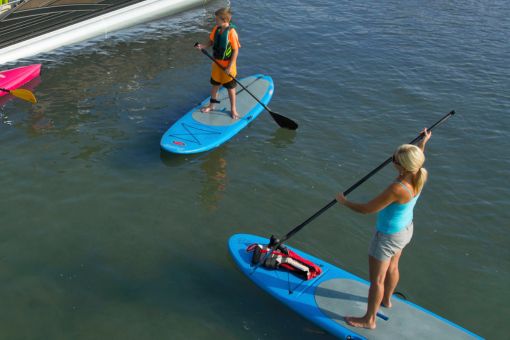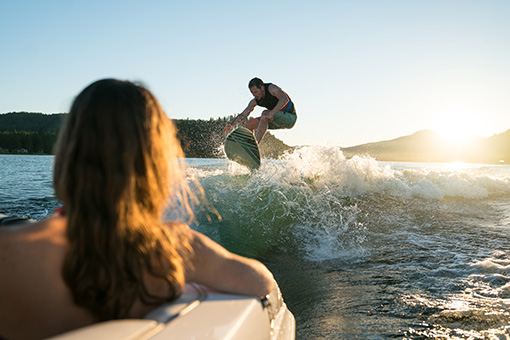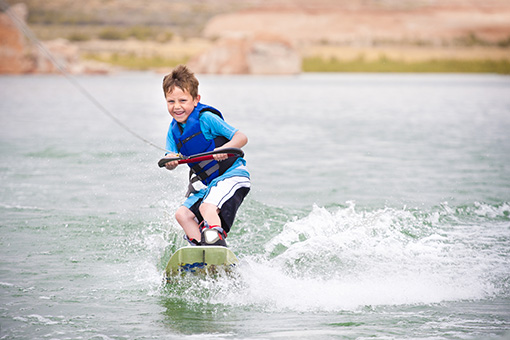Stand up paddleboarding (SUP) is one of the fastest-growing water sports, offering a fun and easy way to explore calm waters while getting a full-body workout. Whether you’re launching from the beach, a dock, or even a boat, learning the basics is key to enjoying your time on the water safely and efficiently. In this guide, we’ll cover everything you need to know, from how to stand up on your board to proper paddle techniques, safety tips, and stowing your gear.

Getting Started: How to Stand Up on a Paddleboard
- Find a Calm Spot: Choose a calm body of water like a lake or slow-moving river to practice your skills. Starting in calmer conditions helps you focus on your balance and paddle stroke without dealing with waves or current. It's also helpful to practice near a dock or shoreline so you can easily return if needed.
- Position Your Board: Place your board in shallow water and make sure it’s facing away from obstacles. Make sure the fin is not dragging on the bottom and that your leash is secured. If the water is choppy, position the nose of your board into the waves for better stability.
- Kneel on the Board: Start by kneeling in the middle of the board, holding your paddle horizontally across the board for balance. This helps you get comfortable with the board's movement before standing. Spend some time paddling from your knees to understand how the board reacts to weight shifts. This practice also allows you to get familiar with maneuvering before fully standing up.
- Stand Up Slowly: When you feel stable, place your hands on the board, one foot at a time, and slowly stand up, keeping your knees slightly bent. Engage your core and keep your eyes forward for better balance. If you feel unsteady, return to your knees and try again. Mastering the transition from kneeling to standing is crucial for building confidence.
- Find Your Balance: Look forward, not at your feet, and keep your feet shoulder-width apart for stability. Slight adjustments in your stance will help maintain balance as you paddle. Your knees should remain soft to absorb small waves or ripples in the water. Always keep your weight centered and your back straight to maintain a strong paddling posture.
Paddleboarding Tips for Beginners
- Hold the Paddle Correctly: Make sure the blade is angled forward. Your top hand should grip the handle, while the bottom hand holds the shaft. Proper grip helps maximize power and efficiency. For long paddles, switch sides every few strokes to maintain a straight path.
- Engage Your Core: Use your core muscles for paddling instead of just your arms for better control and less fatigue. This also helps prevent shoulder strain. Think of your body as a lever, using your entire torso to drive each stroke.
- Keep Your Knees Soft: Slightly bent knees help absorb movement and keep you steady on the water. This is especially important if you encounter boat wake or waves. A rigid stance can make it easier to lose balance when unexpected movement occurs.
- Practice Turning: To turn, simply paddle backward on one side or use a sweeping stroke. Practicing in calm water helps you master these maneuvers before tackling more challenging conditions. Mastering turns will help you navigate crowded or tight areas more easily.
- Mind the Wind: Paddling against the wind can be exhausting. Try to paddle out against the wind so your return journey is easier. Strong winds can also cause your board to drift, so always be mindful of your surroundings. Experienced paddlers often use a lower stance to reduce wind resistance.
How to Fall Safely
Falling is part of the learning process. When you do fall, try to:
- Fall Away from the Board: To avoid injury, always try to fall away from your paddleboard. The last thing you want is to fall onto the hard surface of your board. Practice controlled falls so you become familiar with the process.
- Hold onto Your Paddle: If possible, keep hold of your paddle to prevent it from floating away. However, prioritize your safety first. If you lose it, retrieve it calmly after getting back on your board.
- Get Back on Safely: Climb back onto your board from the center, pulling your chest up first, then swinging your legs back on. Avoid climbing from the tail or nose to prevent tipping. Practicing this in shallow water first can help build your confidence.
- Check Your Leash: Ensure your leash is still secured to your ankle or calf. This prevents your board from drifting away, especially in windy conditions.
Safety Gear: PFD and Sun Protection
Wearing a Personal Flotation Device (PFD) is crucial for safety, especially in deeper waters. Always wear one, even if you are a strong swimmer. In many locations, it’s a legal requirement. Some PFDs are designed specifically for paddleboarding, offering flexibility and comfort.
Additionally, use sun protection such as sunscreen, a hat, and polarized sunglasses to protect yourself from harmful UV rays. The reflective surface of the water can intensify sun exposure, making proper protection essential for long paddling sessions. Consider a long-sleeve rash guard for added UV protection. Also, bring water to stay hydrated during long paddling sessions.
Getting On and Off the Board from a Boat
- Getting On: Sit on the edge of the boat, place your paddleboard in the water, and carefully slide onto it while holding your paddle. Keep your weight centered and paddle away from the boat to avoid drifting back into it. If you have a swim platform, it's an excellent spot to launch from.
- Getting Off: When returning to the boat, paddle up slowly, grab hold of the side, and step off carefully, ensuring the board remains steady. Practicing this maneuver in calm water helps you build confidence for real-world scenarios.
Stowing Your Paddleboard Onboard
To properly stow your paddleboard:
- Secure with a Carrying Handle: Use the board's built-in carrying handle for stability when transporting it onboard. Consider using padded straps to prevent scratches or damage during transit.
- Store the Paddle Properly: Keep your paddle out of direct sunlight and secure it so it doesn’t roll or get damaged during transport. Some boaters use dedicated paddle holders or bungee cords to keep it safe.
- Avoid Excessive Sun Exposure: If possible, keep your board out of direct sunlight for prolonged periods. UV rays can weaken the material over time. If space allows, store it in a shaded area or under a tarp.
Ready to Get on the Water?
Stand up paddleboarding is more than just a sport—it’s an experience that connects you with nature, challenges your balance, and enhances your fitness. With the right knowledge, gear, and a bit of practice, anyone can enjoy gliding across serene lakes, gentle rivers, or even coastal waves. Embrace the water with confidence, armed with the safety tips and techniques covered in this guide. Whether paddling solo for solitude or with friends for adventure, each stroke brings you closer to mastering the art of SUP.
One of the unique aspects of paddleboarding is its accessibility. Unlike many other water sports that require extensive equipment or training, SUP allows beginners to get started with just a board, paddle, and a willingness to learn. Its simplicity invites people of all ages and fitness levels to explore the water and enjoy the serenity of being afloat. There’s something undeniably calming about standing on the water, with only the sound of your paddle cutting through the surface.
For those who want to take their skills further, paddleboarding offers countless opportunities to grow. Advanced paddlers often explore new challenges like SUP yoga, long-distance touring, or even paddleboard racing. Learning to handle different water conditions, perfecting your paddle stroke, and exploring new waterways can turn this hobby into a lifelong pursuit of adventure and self-improvement.
Whether you’re paddling along the coastline, exploring hidden coves, or simply enjoying the stillness of a glassy lake, remember that every time you step onto that board, you’re not just participating in a sport—you’re embracing a lifestyle. One that values mindfulness, respect for nature, and a sense of community.
So, grab your board, hit the water, and create memories that ripple far beyond the shoreline. With each stroke, you’re not only moving across the water but building confidence, strength, and a deeper connection to the world around you. Stand up paddleboarding isn’t just about where you go; it’s about the journey of getting there.

